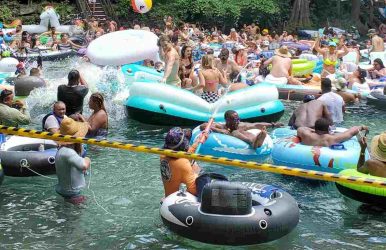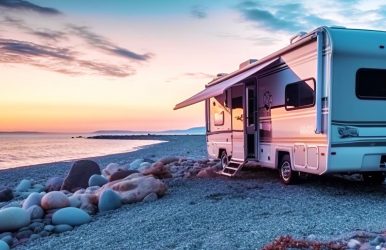Planning A Trip To Ginnie Springs In Florida? All That You Need To Know!
BY Barsha Apr 12, 2023
If you have never visited Ginnie Springs in Florida, then you are definitely in for a real treat. It’s literally the epitome of beauty in Florida - home to the prettiest water in the entire state, Ginnie Springs was on our bucket list for several years. If you haven’t added this to your list of best springs in the United States, then do it ASAP! The water here is a gorgeous shade of blue, and it’s crystal clear. The entire area is quite large - enough for you to go camping and do so much more, in case you get bored of the water activities. Here’s a fun fact about Ginnie Springs - did you know that this spring actually pumps out around 80 million gallons of water every single day? Stay tuned to find out all that you need to know about Ginnie Springs in the Sunshine State of Florida! Exploring Ginnie Springs: All That You Need To Know About This Popular Tourist Spot! Nope, you don’t need to google ‘Ginnie Springs Florida’ - instead, join us as we go on a tour of this popular tourist spot in Florida. It’s a simple choice, really - if you are seeking any pretty places for swimming around, taking part in different water recreation activities, or having fun this Summer, then you should definitely consider visiting Ginnie Springs! But at the same time, it is vital to remember that Springs can get pretty busy and even crowded. After all, it is one of those only springs located in Florida where you can drink. Naturally, this makes the spot crowded with college kids and frat boys on weekends and holidays. Since the spring is owned privately (by the Wray family), drinking is allowed, unlike other famous springs in Florida State parks or even inside the main city. Without wasting any time, let’s get started - scroll down to find out all that you need to know about this tourist destination! Location: Where Is Ginnie Springs Located In Florida? Of course, you can just type ‘Ginnie Springs outdoors LLC’ on Google and let your GPS do the magic. But if you hate traveling without doing detailed research, then let’s find out where this Springs is located in Florida. Connected to the beautiful Santa Fe River, Ginnie Springs is situated only 6.5 miles away from High Springs. Known to be one of the most popular North Florida springs, Ginny Springs is only 48 minutes from Gainesville and about 60 minutes from the Florida-Georgia border located on 75 Highway. You can also drive to this location from Tampa - it will take you 2 hours to drive to the location and the same time to go back. Here’s the complete address: 7300 Ginnie Springs Road, High Springs, FL 32643 Costing: How Much Does It Cost To Plan A Trip To Ginnie Springs? There’s literally no accurate answer when it comes to determining the exact cost of visiting the glorious Ginnie Springs! There’s so much to do here - from general admission costs to paddle boating, camping, or even diving, which comes with its own individual costing. As compared to other affordably priced Florida springs like Rock Springs/Kelly Park, Ginny Springs is relatively more expensive. For instance, spending 15 to 20 dollars on just admission for every adult is quite steep. But then again, the beauty of the place, accompanied by all the additional facilities, makes it worth the cost. General Admission Fees: In general, here are the general admission fees! Adults (season): 20 USD/ person Adults (off-season): 15 USD/person Children (5-12): 5 USD/person Children (4 And Below): Free Camping: It is possible that you might want to explore the Springs camping options - this is precisely why we have managed to find different camping rates for you. Scroll down to find out now! Adults (season): 30 USD/ person Adults (off-season): 25 USD/person Children (5-12): 8 USD/person Children (4 And Below): Free Electricity and Water on site (standard): 11 USD Electricity and Water on site (for groups): 22 USD Scuba Diving: A trip to Ginnie Springs is incomplete if you miss out on scuba diving. But of course, there’s a separate pricing structure for the same. Scroll down to find out about the scuba diving rates. Certified Full Cave Divers (or Equivalent): 24 USD/person All Other Certified Divers: 32 USD/person Annual Dive Pass (Cave - Cavern): 399 USD Please Note: Scuba diving is prohibited on certain holidays or even on major weekends. Timing: When Does Ginnie Springs Open Or Close? The timing of Ginnie Springs depends on two important factors, The season, and The day. So, the timing can change depending on the season and even the particular weekday. Of course, if you are camping, then the springs will be open throughout the day for you. For other visitors, it entirely depends on when the sun sets - for instance, during Winter, the park closes anytime between 6 pm to 8 pm, and sometimes, even later! Then again, it also matters whether you are visiting the Springs on a weekday or a weekend! So if you do visit this Springs anytime soon, here’s the seasonal timing for now! Monday - Thursday: 8 am to 5 pm Friday - Saturday: 8 am to 7 pm Sunday: 8 am to 6 pm. Things To Do In Ginnie Springs! It is quite nice that Ginnie Springs is one of the best places to visit for holiday! You can experience a lot, both culturally and naturally. There are beautiful small shops for art supplies, thrift shops and others. The communities at the Ginnie Springs are quite positive and supportive towards visitors and tourists! Follow Anderson’s Outdoor Adventures Santa Fe River Park! When visiting Anderson’s Outdoor Adventures Santa Fe River Park, you have 3 hours to enjoy the activities. You can rent a paddle board, tube, kayak and canoe on site for people who are in love with adventure. The view at the Santa Fe River is so beautiful and you can perform the activities 365 days of the year! It is a great place but you can have a guided tour or take a river trip. The area is pretty close to Ginnie Springs and Blue Springs Park! Swimming Lizard Paddle! You go for official paddle boarding lessons at the Swimming Lizard Paddle along with getting tours and rentals. There is a beginner lesson yet there is a tour where you can get coaching sessions thus, creating comfort, stability and speed for you. There is an eco-tour that you can take across the Santa Fe River! You will get a workout session which will help you physically and mentally, thus creating an effective outdoor activity session. Visit O’Leno State Park! It is a scenic view situated right across the banks of Santa Fe River. There are significant features on the park such as river swamps, sandhills, hardwood hammocks and sinkholes. The river Santa Fe travels across the park and at one point it goes underground and then re-emerges at the River Rise State Preserve. There was a suspension bridge built spanning the river by the Civilian Conservation Corps in the 1930s. Bicycles and canoes are also available for rent and people often rent them to take a look at the wildlife across the nature trails in the park! There are native plants that you can check out across the full facility campground which is shady for the morning trails while perfect for overnight stays! Drink At The High Springs Brewing Company! High Spring Brewing Company is a brewery that is family-owned! It is located in High Springs, Florida which is a historical place. They have a take on traditional beer styles so you can visit the brewery with your partner or friends to experience some of the best drinks in life. Further, there are some activities and events that they regularly organize. So you can easily check the activities from the website and visit the local restaurants nearby! Exploring Ginnie Springs: Reviews From Visitors There’s no way you can actually plan a trip to a popular spot like Springs without talking to people who have already visited the place before. So today, we decided to go to two high-authority websites for guest reviews, Google (rated 4.4/5), and Tripadvisor (rated 3.5/5). Ginnie Springs Reviews On Google: The top Google reviews on Ginnie Springs are as follows, 1. Review By Misty “Amber” Richardson: The springs are beautiful, the water is so clear you can see all the way to the bottom. They have inner tube kayaks and paddle boards that you can rent for the day and free life vest rentals, or you can bring your own. You can swim in the springs or float down the river to one of the pickup points. It is a great place for the whole family to spend the day or even go camping. 2. Review By Gavan Berzman: This is one of my favorite places on earth. You're able to camp along the river. It's $30 for a tent site. Clean bathrooms and showers nearby. Lots of grills, picnic tables, and volleyball courts throughout. The springs are absolutely amazing. I always leave feeling like a new man. 3. Review By N Mateo: Views were beautiful. This is a campsite with very reasonable pricing and set-ups. Amenities were great, and showers and restrooms were well maintained. Snack bar on site. The activities include snorkeling, canoes, trails, etc. Cons: quite a few closed off areas, but I will still definitely visit here again. Ginnie Springs Reviews On Tripadvisor: The top reviews about Ginnie Springs on Tripadvisor are as follows, 1. Review By GoPlaces202808: Beautiful place completely ruined by obnoxious college students blaring extremely loud vulgar music throughout the campgrounds at all hours of the night. The quiet hours, which don't even start until midnight, are only loosely enforced. The bathrooms are far too small to handle the crowds and are disgusting by evening time. The tubing exit site should be renamed Beer Can Springs since that is what is mostly seen on the bottom there. 2. Review By Jennifer H: We went previously and had fun, but we paid $20 a person, and we brought our own tunes. There was literally trash floating past us. My daughter actually started picking up trash. I was very unhappy we would not be going back. 3. Review By Exploration577906: Not worth your money and time. We waited 1 1/2 hours just to get in and rent a kayak. Long line, and it doesn’t even move. The security gay does a poor job managing the door, and people come in and out while you wait. And It’s A Wrap! And that’s a wrap on planning a visit to Ginnie Springs located in Florida. What do you think about visiting this much-loved tourist spot in the sunshine state of Florida? If you have already been here in the past, then we would definitely want to find out more about your experience - so feel free to share your thoughts and experiences about Ginnie Springs in the comments below. Read Also: Top 10 Best Beaches In Florida Top 8+ Splash Pad Near Me In Florida (Updated 2023) 10 Best Fishing Charters In Florida To Visit – Tour And Travel Guide















